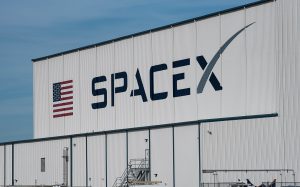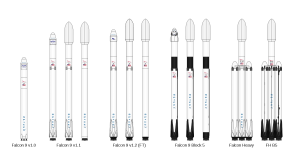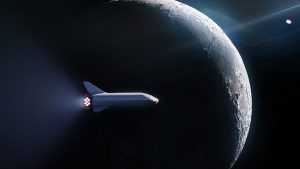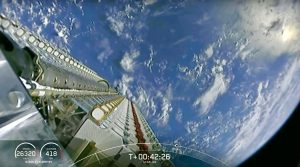Among all companies, SpaceX is the most focused on how to catapult humanity into the future and into space in the next decades. The objective is to make space-related technology more efficient and affordable in order to make outside-Earth exploration and colonization easier.

Image source: https://commons.wikimedia.org/wiki/File:SpaceX_Hangar.jpg
What Is SpaceX About?
SpaceX (full name: Space Exploration Technologies Corporation) is a private American rocket company founded in 2002 by Elon Musk. The main objective is to make space-reaching operations more affordable and cost-effective, just as their motto states: “Revolutionizing access to space”.
The advancement SpaceX is most well-known for is the availment of smart rocket boosters that can take payload into outer space, fly back to Earth and perform an autonomous landing. This means that they are reusable, hence the long term cost of space operations can be lowered by a considerable amount.
SpaceX works on projects/operations like the Falcon rockets, the Starlink internet satellites, the Dragon reusable space crafts and a sci-fi worthy space colonization craft called Starship.

Image source:https://commons.wikimedia.org/wiki/File:Falcon_9_close_up.jpeg
Rockets, Space Crafts And The (Many) Achievements:
Given the pioneering spirit of this company, it is safe to say that it’s clear it was meant to break records. And so it did, year after year.
In 2008, SpaceX reached their first milestone: it became the first private company able to send a liquid-fueled rocket into orbit, the Falcon 1. Their first attempt dates back to 2006, but they’ve come a long way since then.
In 2010 they became the first company to successfully send to orbit and land safely a space craft, the Dragon pod. It has been reused in 2017 for a flight to the ISS (International Space Station).
In 2010 again, they’ve launched their first Falcon 9 rocket (named “9” after its nine engines) which was designed so its first stage could be reused. One of the boosters that returned to Earth has been successfully used again in a different launch in 2017.
In 2018 SpaceX declared that Yusaku Maezawa, art collector and curator will be the company’s first private passenger to fly around the Moon in a 2023 launch.
The current top-of-the-line craft from SpaceX would be the Falcon Heavy, a rocket composed of three Falcon 9 nine-engine cores and a central fuselage. It had its first test in 2018, which was overall a success, with only one out of three smart boosters that couldn’t make it correctly back on Earth. The occurrence was the iconic mission in which a Tesla Roadster with a buckled up mannequin was placed into orbit around our Sun.
Finally, in recent 2020 the first crewed (2 astronauts) Dragon capsule launch occurred.

Image source: https://commons.wikimedia.org/wiki/File:Falcon9_rocket_family.svg . Author: Lucabon
Super Heavy-Starship And Space Exploration:
SpaceX’s “Starship” spacecraft and “Super Heavy” rocket are reusable means of transport designed to transfer both crew and payload to orbit, Moon, Mars and hopefully beyond. Once finalized, it will be the most powerful launch vehicle ever. It is 120m tall and it will be able to carry over 100 tons of cargo in LEO (Low Earth Orbit = 160km to 1000km above sea level).
Super Heavy-Starship’s upper stage is a 50m tall spacecraft called “Starship”. Both Starship and Super Heavy will be entirely reusable, making space exploration and colonization or other ambitious probing missions economically viable. The whole system can also be utilized for high-speed journeys between different locations on our planet.

Image source: https://search.creativecommons.org/photos/6a27dbbe-a03b-4c4c-9aad-1c1cb0ba6b0d
What Is Starlink And Why It Is Relevant:
Starlink refers to a constellation of satellites devoted to provide internet access on Earth.
The main advantage of this system comes from its shorter distance from our planet (circa 60 times closer than average internet satellites). This reduces latency, enhances performance for video calls, cloud services and gaming, improves reliability and delivers more than discrete speeds that wouldn’t be typically possible with traditional systems. It aims to bring better internet access all over the world regardless of the area the signal is being picked up from. Currently, there’s a total of 422 Starlink stations above Earth, requiring about 800 for optimal results; they are full fledged satellites colored in dark hues (they won’t interfere with astronomical activities on Earth), equipped with solar panels and vector thrust.
Needless to say, the Starlink constellation is being deployed in space by reusable SpaceX rockets.

Image source: https://search.creativecommons.org/photos/4ae71520-eb3c-4ab5-8a41-6bb13f449342. by jurvetson
Info source:
https://it.wikipedia.org/wiki/SpaceX
https://www.britannica.com/topic/SpaceX
https://www.bbc.com/news/science-environment-55564448
https://www.space.com/spacex-starship-super-heavy-landing-plans
